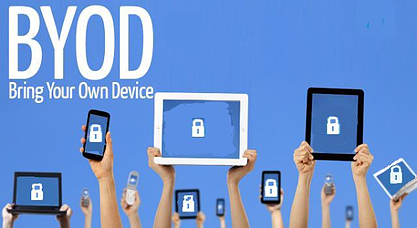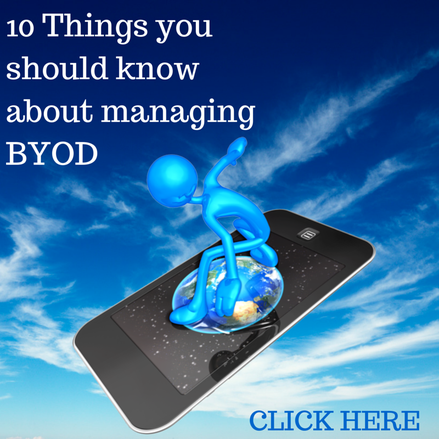Tons of small businesses are throwing BYOD parties. Do you want to Party?
BYOD refers to “bring your own device,” an emerging trend in technology where people bring their own devices to companies,
 organizations and events, and use them to do their work. This new trend is VERY HOT. Smokin’ hot. Here are a few key findings:
organizations and events, and use them to do their work. This new trend is VERY HOT. Smokin’ hot. Here are a few key findings:
- 89% of worldwide IT departments support some form of BYOD.
- 69% of global IT leaders think the benefits of BYOD are positive.
- 51% of workers use their personal smartphones as their BYOD device, 44% use their laptops or ultra-books, and 31% use tablets.
And just like any really great party, this one can be a blast as long as you have good security. In fact, that’s the real catch to making BYOD work for an organization – Mobile Device Management (MDM). You’re weighing gains in productivity and potential reductions in capital expenditures against the need to maintain a secure IT environment. It’s a careful balancing act, but could really be worth the effort. In fact, according to estimates by Cisco’s Internet Business Solutions Group, the annual savings from BYOD could range from $300 to $1,300 per employee, depending on their role in the organization.
So if you decide to throw your own BYOD party, how do you get started? Here are some tips to get you going:
Get IT involved from the start.
Whether you have an IT department, or just someone that oversees your network, get them involved in the BYOD conversation right away. Take some time to explain the gains that BYOD can provide through increased flexibility and accessibility for customers. NSK Inc can help you with your concerns, and empower you to research ways to address them. If there are security issues that need to be addressed in order to accommodate BYOD, provide IT with the means to patch them. Listening to IT is key to getting them to buy in. Give them a set of custom ear buds to make the point that you’re hearing what they have to say.
Decide how far you want to go.
Adopting BYOD at your organization doesn’t have to be an all or nothing decision. A recent white paper from Hewlett-Packard® illustrates four distinct BYOD approaches:
- Embrace—allow everyone to use any device to access all of the various IT resources.
- Contain—allow some people to access a limited selection of devices to access a selected group of IT resources.
- Disregard—ignore the presence of personal devices in your corporate environment all together.
- Block—ban the use of consumer devices and services by drafting a specific policy that explicitly prohibits their use.
According to that same white paper, research firm Gartner® recommends most companies start with a Contain strategy. It gives companies the ability to start with a small group of users and devices accessing a controlled amount of resources. It limits security risks and provides a great foundation to expand upon.
Select a core group of internal “pioneers” to test the program, a group of people who have roles that could really benefit from the increased mobility and flexibility that BYOD offers. Get them excited about breaking new ground, and help them protect their devices by giving them a customized smartphone case or an iPad® sleeve. Or, help them stay productive while visiting customers with a customized cell phone charger.
Draft a clear, easy to understand security policy.
Just remember, security is here for your protection, not to kill your BYOD buzz. Having a clear and easy to understand security policy, whichever BYOD approach you choose to pursue, will make your party a lot more fun for everyone. Consider doing a risk assessment review in cooperation with your IT department. If you’ve been listening to their concerns, you’re probably already halfway there. In addition to the risk assessment, educate your employees on the potential security risks to the company. Make them aware of actions they perform on their personal devices that would leave the company vulnerable to a security threat.
From there, draft a policy that clearly defines the acceptable use of personal devices for your organization. Review the policy with your employees and address their questions. And, of course, keep IT involved throughout the drafting and education process. Keep security top of mind by giving your employees a silicone padlock luggage tag to put on their computer bags. Nothing says secure like a silicone padlock.
Party responsibly.
BYOD offers companies of all sizes the chance to increase productivity, reduce capital expenditures on technology, and be more accessible to customers, all while providing an enhanced user experience and greater convenience for employees. Taking the time to evaluate an approach to BYOD that’s right for your company, and working with IT to make sure your IT environment is secure can help you realize all of the gains BYOD offers while maintaining your security.
4Imprint – Newsletter 5-9-2013
Nelson, Lindsey. "Bring Your Own Device Policies Are Changing The Way We Work Across The Globe." Business Insider. Business Insider, Inc., 24 Jan. 2013. Web. 11 Mar. 2013.
DiDio, Laura. "Is Imperative for BYOD, Mobile Deployments." Web log post.Information Technology Intelligence Consulting. ITIC, 5 Sept. 2012. Web. 12 Mar. 2013.
Cisco. Internet Business Solutions Group. Cisco Study: IT Saying Yes To BYOD. Cisco: The Network. Cisco, 16 May 2012. Web. 11 Mar. 2013.
Hewlett-Packard Development Company, L.P. "Deliver unparalleled business advantage with bring your own device - A holistic approach to BYOD security and management." CIO. Ed. Brian Carlson, Brian Eastwood, Al Sacco, Dan Muse, and Shane O'Neill. Hewlett-Packard Development Company, L.P., Oct. 2012. Web. 11 Mar. 2013.
BYOD Picture - http://www.securedgenetworks.com/secure-edge-networks-blog/bid/78530/4-Tips-for-BYOD-on-School-Wireless-Networks

